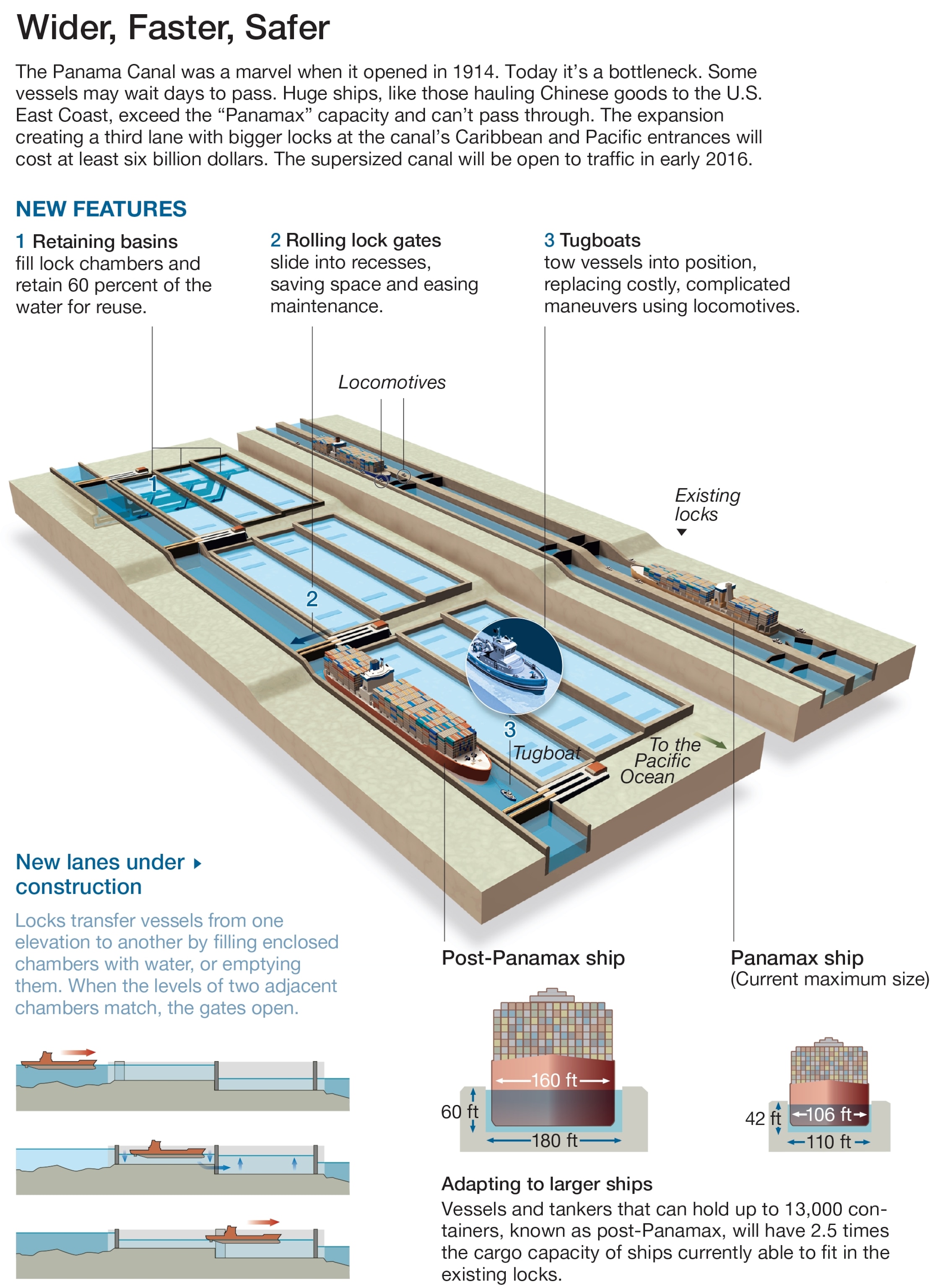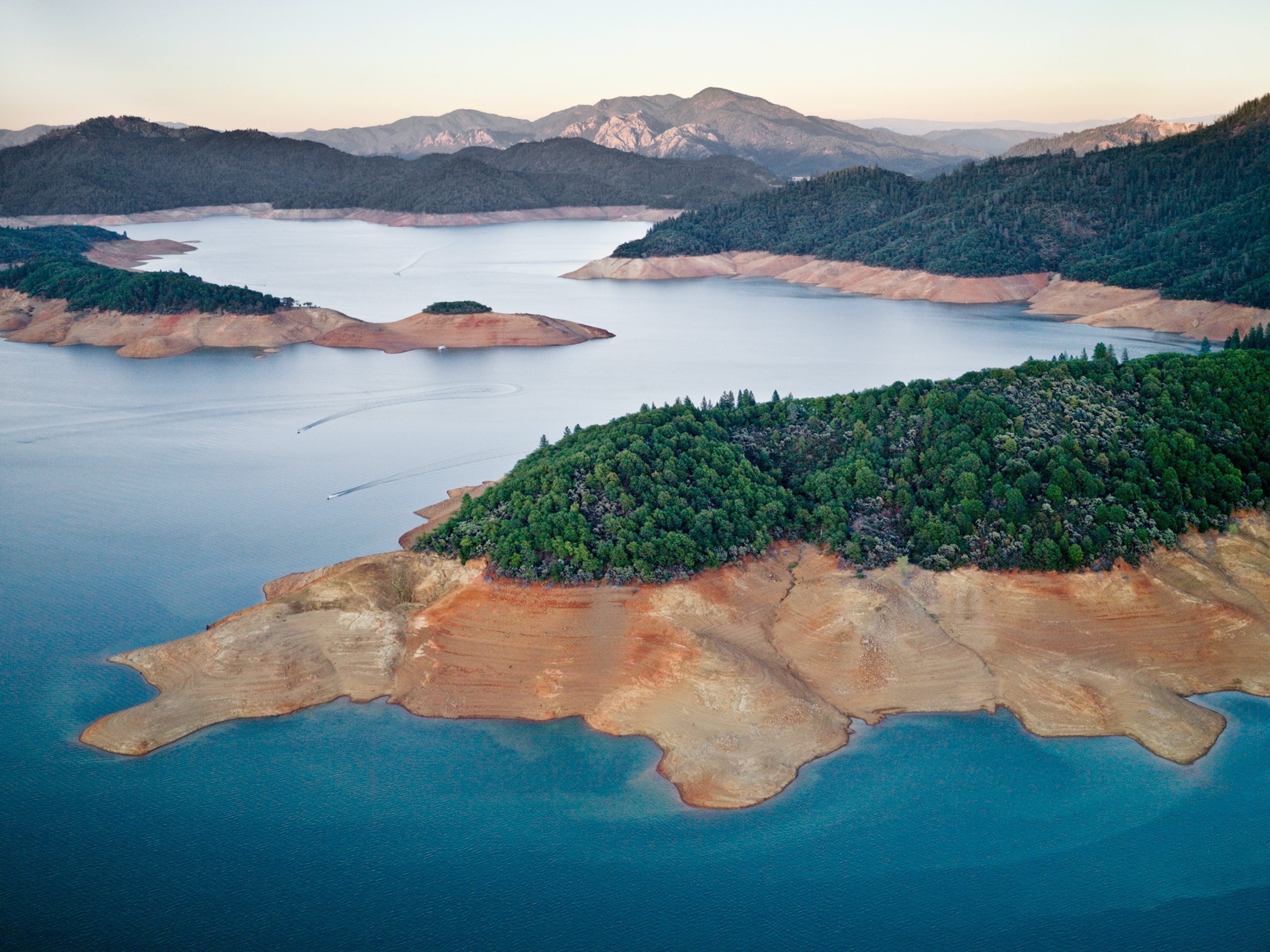
A Hundred Years Old Today, the Panama Canal Is About to Get a Lot Bigger
To accommodate today's oceangoing behemoths, the canal is getting a $6 billion makeover.
Even after a century of constant use and the passage of more than a million ships, the great steel gates of the Miraflores locks, at the Pacific entrance of the Panama Canal, still swing open with the precision of a Swiss watch.
So exquisitely fitted and balanced are they that each of the 672-ton leaves can be moved by a pair of 25-horsepower motors. The same can be said for the massive Gatun locks on the Caribbean side. Engineered in the days of Teddy Roosevelt, their doors cast in good Pittsburgh steel, the locks—like the canal itself—were designed to handle with ease ships the size of the Titanic.
And so they can still—as long as the ships come that small.
Nowadays many don't. Of the roughly 14,000 ships that transit the Panama Canal each year, more than half have beams in excess of a hundred feet and can barely squeeze through the old locks, which can accommodate ships up to 106 feet wide. The Titanic, by comparison, had a relatively svelte 92-foot beam.
Finessing a large, modern ship through the locks isn't for the faint of heart.
"Picture yourself more than 700 feet from the bow of a vessel, standing on a bridge that's 12 to 15 stories high, and then easing it forward into the lock with only two feet of clearance either side," says Captain Miguel Rodriguez, a veteran canal pilot and president of the canal's board of inspectors, "and you'll have some idea what it's like piloting a big vessel into the lock. Then imagine doing it in the dark and in the rain."
As skillful as Captain Rodriguez and his fellow pilots may be, even their talents only go so far.

Era of the Behemoths
An increasing percentage of the world's ships—more than a third of bulk carriers, tankers, and container vessels, as well as the biggest of the glitzy new cruise liners—simply can't use the Panama Canal at all. They're just too big.
Indeed, a study by the U.S. Army Corps of Engineers predicts that by 2030 nearly two-thirds of the world's container ships would be too big to use the existing locks in the Panama Canal. (Related: "Is Nicaraguan Canal a Boon for Trade or a Boondoggle?")
As it is, the colorful old canal, which is celebrating its hundredth birthday this week, has been losing market share in recent years, with Asian companies preferring to use bigger, more cost-effective vessels via the Suez Canal or to ship their goods to the U.S. West Coast and move them onward by rail.


Supersize Me!
In 2006, Panamanians voted to give their canal a $6 billion makeover: dredging its channels, widening the famous Culebra Cut across the Continental Divide, and constructing a gigantic new set of state-of-the-art locks 1,400 feet long and 180 feet wide. Work began in 2007, and as of this week, it's 80 percent complete.
When the new locks eventually open for business, sometime in the first quarter of 2016, the grand new Panama Canal will have double the cargo capacity of the old. It will be able to handle 99 percent of the world's container ships and 81 percent of the huge liquefied natural gas (LNG) tankers—almost none of which use it now.
It will be a pivotal moment, says Valentine Lynch, vice president of planning and business development for the Panama Canal Authority. "Not just for Panama but for the all of the trade-driven commerce that is impacted by the Panama route."

Seaports Scrambling
The money being spent to widen the canal is modest compared to the billions that seaports on the U.S. eastern seaboard are spending to prepare for the arrival of the massive container ships from Asia once the newly widened canal is opened.
From Miami to Boston, harbors are being dredged, road and rail links expanded, and huge new cranes put in place to unload the more than 13,000 containers that each of the giant carriers can hold—enough storage space for a million flat-screen TVs or more than a hundred million pairs of running shoes in a single load.
The Bayonne Bridge, between New York City and New Jersey, is being raised—at a cost of a billion dollars—to give the towering ships room to pass through.
In Baltimore, a new intermodal railway complex is being built to help haul away the thousands of containers.
A $600 million tunnel is being dug under Miami so trucks hauling thousands of containers away from the docks can bypass downtown streets.

Ports around the Caribbean and South America—Jamaica, the Dominican Republic, Cuba, and Venezuela—are also scrambling. "With East Asia sourcing more and more raw materials out of Latin America, in particular coal and iron ore, the expanded canal will offer enormous new opportunities," Lynch says.
American soybean farmers will also benefit. More than a third of the harvest is already exported through the Panama Canal. Expanded locks and bigger carriers will allow farmers to deliver more of their crop to Asian markets more cheaply.
Perhaps the biggest beneficiaries, Lynch says, will be the U.S. natural gas industry centered on the Gulf of Mexico. "The expanded canal will facilitate transporting gas from the gulf to Asia," he says. "Most of the LNG vessels can't transit through the existing canal but will be able to transit through the expanded canal." (See "North American Natural Gas Seeks Markets Overseas.")

A Monumental Undertaking
Building a canal across the Isthmus of Panama—or expanding an existing one—is a monumental undertaking.
The original timetable for the expansion called for the new set of locks to be launched this week as the showpiece of the hundredth anniversary celebrations. Cost overruns and construction delays pushed the date back 18 months.
At that, today's canal builders are having a pretty smooth ride compared with the engineers whose efforts they're celebrating this week. (See "Picture Archive: Building the Panama Canal, 1900s.")
The French, who made the first attempt to build the canal, starting in 1881, lost thousands of workers to malaria and yellow fever before giving up and eventually selling their concession to the U.S. government in 1903.
The Americans also found it tough going, with mudslides, yellow fever, and the jungle itself taking a heavy toll.
But unlike the French, who had been determined to build a sea-level canal just like the one they'd built at Suez, American engineers opted for an ingenious series of locks to lift ships up and over the Continental Divide. The locks they built are still in use today—and will continue to be used after the new ones come on-stream in 2016.
"My hat goes off to those guys," says Ilya Marotta, executive vice president of engineering for the Panama Canal Authority, who's been overseeing the expansion project. "They were geniuses. With far less technology than we have today, they accomplished something remarkable and built a project which is still running like a charm a hundred years later."

With today's technology, she says, "it's been a lot easier to build these locks than it was for the builders of the original ones. We didn't have the health issues they had, and safety standards have come a long way."
According to Marotta, the biggest challenge, aside from the sheer magnitude of the project, was coordinating the efforts of the multinational consortium that came together to build it.
"This project brought together talents and expertise from all over the world. The gates were designed in the Netherlands and fabricated in Italy. The valves came from Korea. Other components were made in the USA, China, France, Italy, Germany, and Spain. It's a worldwide project taking shape in Panama."
The Panamanian jungle is as lush and green as ever, and a hundred years after the S.S. Ancon steamed into history by becoming the first vessel officially to transit the Panama Canal, the 48-mile passage between the seas is still one of the most flamboyant journeys on Earth, bright with parrots and the flavor of the exotic.
Pilot's Pleasure
It's a journey that Captain Rodriguez has never grown tired of, despite making well over 1,500 transits on every kind of vessel in his 27 years as a canal pilot.
"It's an incredible job," he says. "At the end of each transit, you get instant gratification when you see your work done, say goodbye to the master of the ship at the end of the transit, and watch the vessel depart from Panama."
It's stressful work, no doubt, but it's also unique and a source of great pride. Panama Canal pilots are the only ones in the world who actually relieve the master and take control of the navigation and movement of the vessel.

Getting used to the giant new locks will be a challenge, as will maneuvering enormous ships through the navigation channels in the Culebra Cut and Lake Gatun.
"We're already training on simulators for the day when the new locks come into service," Captain Rodriguez says. "The new locks on the Atlantic side are expected to be ready for testing a few months prior to the ones on the Pacific, so we're planning on taking advantage of that to perform some training and testing with a vessel we'll lease just for this purpose.
"I don't know who'll be the first pilot to go through these new locks," he says, jokingly suggesting that the senior pilots could draw straws for the honor.
"I know I'm certainly looking forward to the day I do go through them as a pilot. A lot of work and effort has been put into this, and I'd love to be part of that history. It will be a proud moment for many of us and for Panama."







